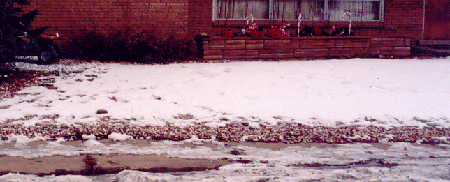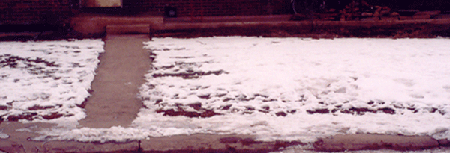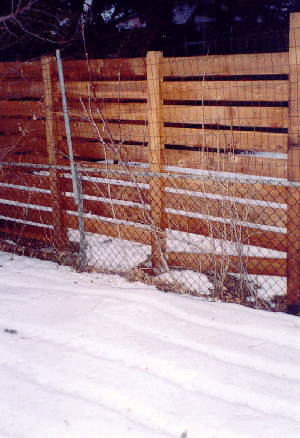Before we leave human effects on “local” climate, I wanted to share a few more examples to show how we can change our local climate.
I’ve written some about how land use affects temperature in cities; I’ve also mentioned in a previous blog how shadows affect snow melt. Here are some more examples:
1. Effect of land cover on snowmelt.
Last winter, I took the three pictures (below) in Boulder, Colorado (40° North latitude) within a few minutes of each other. All three are of yards exposed to the sun – they are on the south side of the house.

Figure 1. Snow on yard covered with gravel. Snow depth 1-2 cm.

Figure 2. Snow on yard with thick grass. Snow depth 15cm.

Figure 3. Snow on yard with sparse grass. Snow depth 2-5 cm.
When comparing the pictures, keep in mind the snowfall was the same at all three places. The three places received about the same amount of sunlight. Also, these yards are so small – only about 20 meters wide – that the wind will even out the air temperature.
So why is there a difference? The clue is the difference in the ground cover.
To understand what is going on, we need to know something about the temperature of the soil and how it changes. The soil temperature several meters below the ground surface remains almost constant through the year. In fact, cave explorers tell me that the temperature in a cave (10s of meters or less below the surface) is approximately equal to the annual average temperature of the air overhead at the surface. (Mines a kilometer or more below the surface, on the other hand, are much warmer – the temperature goes up as you approach the center of the Earth.) Further, soil “holds” heat. When cold air flows over warm ground, and it starts snowing, the snow melts until the ground cools to freezing at the surface (it takes longer to cool the soil below the surface).
Thus warm soil below is available to heat up the surface and melt snow, even when the air temperature is below freezing. So, as described in an earlier blog, snow melt was happening from the bottom since the soil was much warmer than the air.
In what yard has the soil remained the warmest? This is clearly in Figure 2, since the snow has melted the least. The thick grass acts as insulation; it keeps the soil warm, by keeping the warmth of the soil from reaching the surface. (As long as the yards are all covered with snow, the effect from heating from the air and sun will be similar).
In what yard has the snow melted the most? This is clearly in Figure 1. There is no grass at all to insulate the soil from the cold; so the soil’s (and the rocks’) heat was used to melt the snow.
If you measured the temperature at 15 cm below the ground at the time the picture was taken, the temperature below the thick grass would be the warmest, and the temperature below the rocky yard would be the coolest.
A few days later, the rocky yard was bare; and the surface temperature could then climb above freezing. This yard is obviously going to be the warmest in the summer as well. This yard has created a microclimate that is warmer than the surroundings.
On the other hand, the lawn with the thick grass had the snow the longest. In the summer, this yard has a microclimate that is slightly cooler than the other yards. (Remember how evapotranspiration uses a larger share of the available energy from sunlight and downwelling infrared radiation?) Of course the wind from other yards reduces the cooling effect.
How does the “sparse grass” yard in Figure 3 compare to the yards in Figure 1 and Figure 2?
2. Another example of the effects of shadows
Finally, I show the effect of shadow in Figure 4. In this picture, you can see the snow has melted more where the snow is not shaded by the fence. Obviously, the fence is also affecting the local microclimate.

Figure 4. Snow melt pattern caused by shading by the fence.
In the previous few blogs, I have written about how we can modify our local climate. Can you think of ways that you can make your local climate cooler in the summer time? Can you think of ways that you can make your local climate warmer in the winter time?
For more about soil, see the GLOBE soil protocols.

These are some really fun experiments, I am going to do some similar things with the kids next winter!
That’s wonderful! Let us know the results.
Hey very interesting to see how the ground at different conditions involves and are responsible in microclimate. Thanks for sharing. Just to share with you in summer time to keep my room naturally cooler I always keep it closed during the day time, makes huge difference in the atmosphere. Your post gave me some more clues and ideas to apply. Let me give a try first. If get success will surely share with you.
I’ll be interested to see your results.
In the summertime, we do similar things to keep our house cool, since we don’t have air conditioning. We have two thermometers outside, and two thermometers inside.
During the morning, we wait until the temperature outside gets as warm as inside, and then shut the windows, and draw the southern curtains to keep out the sun. During the evening, we reverse the process — we watch the temperature until it gets cooler outside than inside, and then open up the windows and doors. When it gets really hot, we use fans to help flush out the hot air. Fortunately, it gets cool enough in Colorado that it always gets cooler than the house at night!
This article is very interesting and meaningful